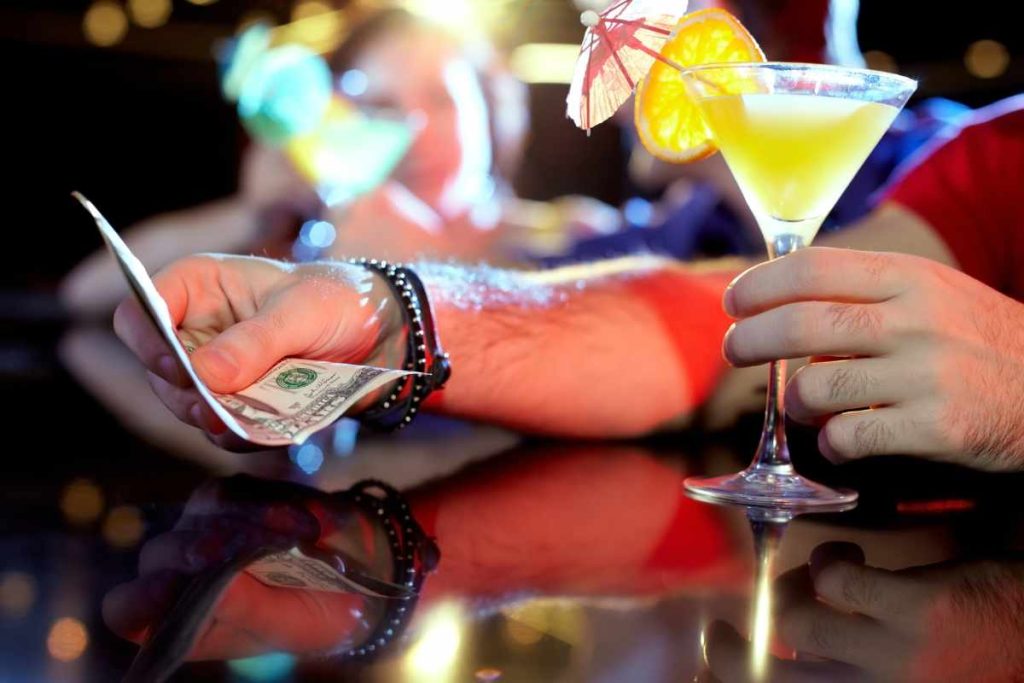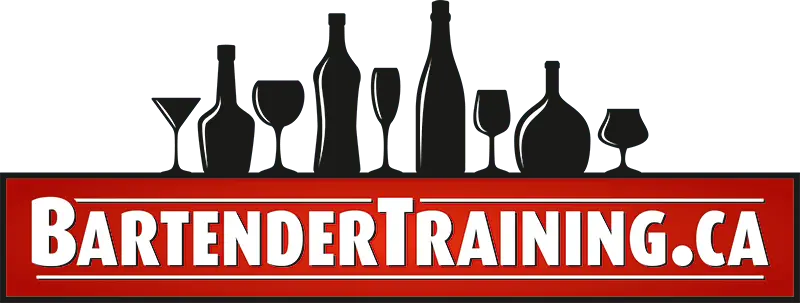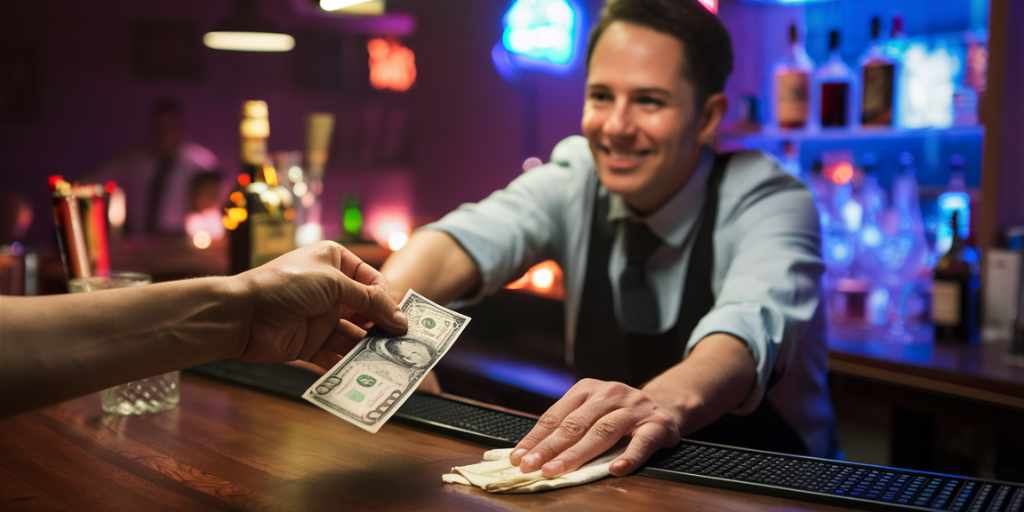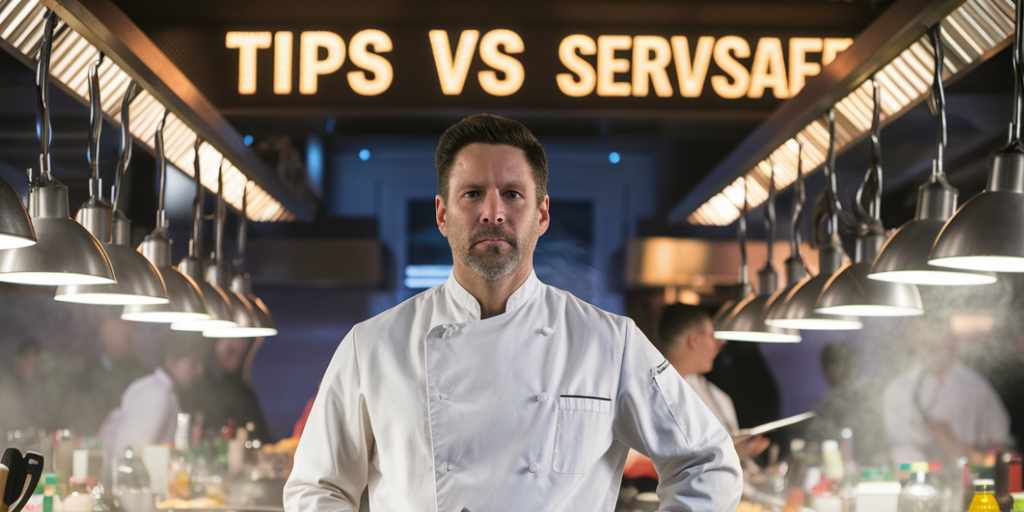Tipping bartenders is an integral part of bar culture and etiquette, holding significance that extends beyond a simple financial transaction. It reflects the value customers place on service quality and their interaction with their bartender. Understanding how much to tip can sometimes be a conundrum for patrons who want to ensure they are compensating fairly without overstepping social norms.
Key Takeaways
- Tipping is a customary practice that complements a bartender’s earnings and reflects the customer’s appreciation of the service.
- The appropriate tip amount can be influenced by the type of service, drink complexity, and the customer’s overall experience.
- Familiarity with tipping etiquette helps maintain a positive dynamic between patrons and bartenders in a bar setting.
The customary tipping practices in bars and restaurants vary by region and establishment, but the role of monetary gratuities is universally acknowledged as part of a bartender’s income. Customers assess various factors when tipping, such as the complexity of their drink, the attention they receive, and the overall experience. Hence, it’s important to consider the practicalities of tipping to appreciate and support the bartender’s service.
Understanding Bartender Tipping
When visiting a bar, patrons should know that tipping is not just a courtesy but a vital element of a bartender’s income. This section will discuss the essentials of tipping etiquette and the financial significance tips hold for bartenders.
The Basics of Bartender Tipping
Proper tipping reflects appreciation for a bartender’s service, which often goes beyond simply preparing drinks. In the United States, it’s customary to tip at least $1 per beer and $2 per cocktail or mixed drink. For those who run a tab, leaving a tip of 15-20% of the total bill is standard.
It’s suggested to tip more generously for complicated drinks or exceptional service. If a patron receives a drink on the house, it’s polite to tip the value of that drink. Payment can usually be made in cash or added to a card transaction.
The Economic Importance of Tips
For many bartenders who earn minimum wage or just slightly higher, tips are a significant part of their pay. Sometimes, tips can make up more than half of their earnings. A bartender’s ability to pay bills and make a living may heavily depend on the money they receive from tips.
Tipping also acknowledges the skill and effort a bartender puts into service. Since the hospitality industry often views tips as a reflection of service quality, customers directly influence a bartender’s financial stability and professional recognition through the cash they leave behind.
Guidelines for Tipping Bartenders
When visiting a bar, patrons should understand the importance of tipping etiquette. Knowledge of appropriate tipping can ensure bartenders are compensated fairly for their service and enhances the overall bar-going experience.
Standard Tipping Rates
The baseline for tipping bartenders normally ranges between 15-20% of the total bill in the United States. However, offering $1-2 per drink for individual drinks is standard practice. Tipping generously for exceptional service or when the bartender goes above and beyond is encouraged.
Tipping on Drink Types
- Beer: Tipping $1 is a common courtesy for a simple beer.
- Wine: When serving wine, a $1-2 tip is typical, depending on the quality and price of the wine.
- Mixed Drinks: A tip of $2 is a good starting point for mixed drinks.
- Fancy Cocktails: With complex or fancy cocktails, typically requiring more skill or ingredients, a tip of $2-3 per drink can reflect the additional effort.
Tips for Cash and Credit Card Transactions
- Cash Tips: When using cash, tips can be given directly after each drink or left on the bar.
- Good Tip: A good rule of thumb is rounding up the cash payment to the nearest dollar for a round of drinks.
- Big Tip: A bigger cash tip may be warranted for larger orders or particularly impressive service.
- Credit Card Tips: If paying with a credit card, tips can be added to the total amount before signing the receipt.
- Tip Generously: Even with electronic payments, there is an opportunity to tip generously if the service is notable.
By adhering to these guidelines, customers can appreciate bartenders’ dedication to crafting enjoyable drinking experiences.
Tipping Etiquette in Bars and Restaurants
Navigating the world of tipping at bars and restaurants involves understanding several nuances, especially during busy times like happy hours or at the end of a long night. Patrons should be aware of appropriate tipping practices to ensure they convey gratitude commensurate with the level of service received.
Tipping During Happy Hours and Special Events
Happy hours and special events often feature discounted prices and may lead to uncertainty about how much to tip. It is recommended to tip based on the full, undiscounted price of the drink. For example:
- Happy Hour: If a cocktail normally costs $10 but is discounted to $5, a tip of $2 is based on the original price is considerate.
- Special Events: For events with an open bar, a single tip of $10-$20 at the beginning of the evening may encourage attentive service.
Tipping at the End of the Night
After any night at a bar, whether it was an average evening or one marked by exceptional service, patrons should adjust their gratuity accordingly.
- Standard Service: A tip of 15-20% of the total bill is the norm.
- Exceptional Service: For bartenders who have gone above and beyond, tipping more than 20% is a kind gesture that reflects the quality of service.
- Cash versus Card: Leaving a cash tip can benefit the bartender by providing immediate access to the funds.
Remember, tipping is not just a transaction; it’s a sign of appreciation for the service provided.
Factors Affecting How Much to Tip

Several key factors should be considered when deciding on the appropriate tip amount for a bartender. These include the complexity of the drink orders, the bartender’s time and effort, and the overall quality of service provided.
Complexity of Drink Orders
The more complex drinks, such as craft cocktails, require a greater skill level and time investment to create. Therefore, it is standard practice to tip higher for complex drink preparation. A lower tip may be considered sufficient for simpler beverages, like a draft beer.
Bartender’s Time and Effort
If the bartender spends significant time engaging with customers, providing recommendations, or preparing multiple drinks, their effort is appreciated with a higher tip. Particularly, when one orders multiple drinks and the bartender efficiently manages to serve them, it merits tipping generously.
Quality of Service Provided
Good service is a crucial factor in determining tip size. This includes the friendliness and professionalism of the bartender and their ability to ensure a satisfying visit. Good service is often rewarded with a tip that reflects the customer’s appreciation for an outstanding experience.
Practical Considerations for Customers

When visiting a bar, customers should know the customary tipping practices and how they play into the total drinking experience. The amount and timing of tips can affect service quality and the overall interaction with the bartending staff.
How to Tip for Rounds of Drinks
For those ordering rounds of drinks, a general rule is to tip $1 per beer and $2 per cocktail. However, when a customer orders a round for their friends, it may be more practical to calculate a tip based on the total bill rather than per item. A total tip of 15-20% is recommended for good service.
When and How to Adjust Your Tip
If a customer experiences service that exceeds expectations, an increased tip demonstrates gratitude and may ensure continued great service. Conversely, if the service is lacking, it’s acceptable for customers to adjust their tip to reflect their experience, but always keeping in mind that a minimal tip is more courteous than no tip, as tips form a significant part of a bartender’s income.
Handling Service Charges and Tip Splitting
Customers should examine their bills for an included service charge. Additional tipping may not be necessary if a service charge is included, but one can still tip extra for exceptional service. When splitting a bill, patrons can individually tip based on their portion, ensuring fair compensation for the bartender’s service.
Frequently Asked Questions

This section addresses common inquiries regarding tipping etiquette for bartenders. It provides clear guidelines to assist patrons in understanding when and how much to tip for various bar services.
How much should you tip on each drink at a bar?
One should typically tip between $1 and $2 for simpler drinks and approximately 20% for more complex cocktails, reflecting the service quality and drink complexity.
Is $1 per drink a good tip?
Yes, tipping $1 per drink is standard for simple beverages like beer from the tap or a glass of wine.
Is it customary to tip a bartender after receiving a complimentary drink?
Even when a drink is complimentary, it is courteous to tip the bartender, usually in the amount of what the drink would have cost or at least $1-2.
What is an appropriate tip for a bartender at a private event?
For private events, a gratuity of 10-20% of the total bar service bill is appropriate, depending on the level of service provided.
Are you supposed to tip on alcohol at dinner?
When alcohol is part of your dinner bill, a tip of 15-20% of the total bill, including the alcohol, is customary.
What are the guidelines for tipping bartenders on a per-night basis?
If frequenting a bar for several hours or the whole night, a patron may tip 15-20% of the final tab or maintain consistent tipping per drink throughout the evening.
What constitutes a good percentage tip for bar service?
A good percentage tip for bar service is generally 15-20% of the total tab, acknowledging the bartender’s overall service quality.
How does the ’50 rule’ apply to tipping bartenders?
The ’50 rule’ suggests tipping 50-100% of the cost of the first drink to make a positive impression and ensure good service throughout the night.
Is 25% a good tip for a bartender?
While 15-20% is standard, a 25% tip demonstrates exceptional satisfaction with the bartender’s service.




